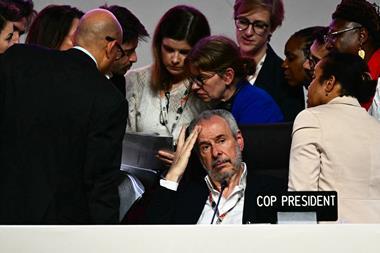From John Holman
Your editorial ’Dear Gordon’ (Chemistry World, June 2007) points to the skills that chemistry graduates can contribute to the economy. Chemistry is a quantitative subject that teaches the scientific use of evidence, and that is one reason why chemistry graduates are so employable.
However, Peter Cotgreave’s article (Chemistry World, June 2007) does not quite meet these high standards of evidence. It is true that wherever possible, pupils should be taught chemistry by a teacher with a chemistry degree, but where is the evidence that half a million pupils have no chemistry teacher? High stakes testing and oppressive health and safety may be putting pressure on practical work, but it’s a gross exaggeration to say that three quarters of schools are abandoning practical work.
There’s plenty more to do to get the basics right in science education, but there’s a strong drive to recruit and train more specialists, and there is major investment in school laboratories that are already well equipped by international standards. These are just two initiatives in science education under the Government’s Science and Innovation Investment Framework - there are more including promotion of ’triple science’ GCSE, investment in Science and Engineering Clubs, and a new programme to promote science careers in schools.
You acknowledge the government’s commitment to science: how about some credit for investment in the future of science education?
J Holman
York, UK
Peter Cotgreave replies: I agree with John Holman that much is being attempted to improve science in schools, and his personal commitment and efforts are a major element of that work. But his criticisms of what I wrote are simply wrong.
In evidence to the House of Lords’ Science & technology committee last year, the government’s own figures showed that 12 per cent of schools teaching 11-16 year-olds had no chemistry specialist teachers.
With 3 306 780 pupils in English secondary schools last year, that means 400 000 of them are without a chemistry teacher. Add in Wales, Scotland and Northern Ireland, and you easily reach my very round figure of ’approximately half a million’ children being taught chemistry by people who are not really chemistry teachers.
I did not claim that three quarters of schools were abandoning practical classes altogether. I wrote that they were cancelling them. When we surveyed heads of science in English secondary schools, we discovered that 77 per cent of respondents were cancelling practical lessons, mainly due to behavioural problems, lack of equipment and overlarge class sizes.
Good work is being done; but we must not be blind to the massive scale of the challenge we face in science education.
From Alan Hayward
David Beerling points out that the main stumbling block in resolving the controversy over whether plants emit methane (Chemistry World, June 2007) is the difficulty of measuring tiny emissions of the gas. The problem might be overcome in situations where respiration rates are very high.
Between the years 1948 to 1962 I was studying food crops in Nigeria. Many tonnes of white yams (Dioscorea rotunda) with excised foliage were being kept in racks in traditional ’yam barns’. As the weight losses during storage were very high, I measured their respiration rates in my Lagos laboratory where temperatures ranged from 26 to 32?C. Although yams are stored with excised foliage they retain their normal diurnal respiratory rhythm. This caused me some loss of sleep and bridge parties were regularly interrupted, causing much amusement, when I had to dash off to tend to my panting yams.
These giant tubers, weighing in the region of 2kg, were respiring at an astonishingly high rate, each one producing up to a litre or more of CO2 every night. But in all of many trials I always found 2-4ml of apparently inert gas which could not be accounted for, and arranged to get help from the chemistry department at Ibadan University in order to identify this mystery gas. In hindsight I wish I had checked its flammability and never suspected that it might be methane. Unfortunately I left Nigeria in 1962 with the mass exodus of expatriates. There was no investigation and no publication.
A researcher might be well rewarded by repeating work of this type on yams in a tropical climate. Two millilitres was a small volume in those days, but is massive for modern instruments.
L A W Hayward CChem, FRSC
Ngaparou, Senegal
From Eric Scerri
I was sorry to read that Dennis Rouvray does not consider my new book on the periodic table as anything very special (Chemistry World, May 2007). The reason for his somewhat mean-spirited review appears to be that I side far too much with the previous comprehensive book on the periodic table by Jan van Spronsen regarding the early history of the subject.
But it so happens that I agree with van Spronsen. Is it so surprising, for example, that I should agree that there were precursors as well as discoverers to the periodic system? Would anyone, Rouvray included, wish to take issue with this obvious notion? But what van Spronsen does not attempt in his classic book is a philosophical analysis of the question of the reduction of chemistry, and in particular of the periodic system, to quantum mechanics. This is the project that motivates my entire book and not the all-too-common tendency to try to produce a revisionist account of previous histories at all costs.
As to the claim by Rouvray that there is little new in the book, I can only assume that he did not reach the later parts of the book. These chapters deal with such issues as the superior electronic configurations of atoms published by a number of chemists such as Langmuir, Main Smith and Bury.
Moreover there are extensive sections on the stellar evolution of the elements, and a number of newly discovered periodic trends such as the knight’s move relationship, none of which have appeared in any books on the periodic system, let alone the classic ones.
E Scerri,
Los Angeles, US
From J Clifford Jones
I had extensive media involvement with the recent terrorist activity in London and Glasgow and would like to reinforce some of the comments I made.
In both incidents, hydrocarbon was the explosive material, specifically propane and gasoline. Hydrocarbon-air mixtures on ignition might, if there is sufficient turbulence, create an overpressure. Such an overpressure, though sufficient to be lethal to persons and to destroy buildings, will be small in comparison with that from a high explosive such as TNT. These always detonate, whereas hydrocarbon-air mixtures display the much less vigorous propagation behaviour of deflagration.
It is possible to make a hydrocarbon-air mixture detonate by rapid compression but such conditions are very different from those in the recent incidents under discussion.
The term ’detonate’ has become synonymous with ’initiate explosion’, but for a hydrocarbon explosion displaying deflagration this is not correct. An explosive hydrocarbon-air mixture simply ignites, and a device enabling it to do so is not a detonator but a provider of an ignition source.
Secondly, whilst the term ’car bomb’ has been in use long enough for acceptance, to use the word ’bomb’ alone to describe a set-up such as that at London or Glasgow is possibly misleading. Fireballs and the like from leaked hydrocarbon occur not only in terrorism but also at petrochemical plants, fuel storage plants and offshore installations and the word ’bomb’ is never applied then.
J C Jones FRSC
Aberdeen, UK
From Norman Nicholson
Brian Malplass’ ’Last Retort’ (Chemistry World, June 2007) reminded me of when I first started in chemistry straight from school in 1945.
I worked for a company in Hatton Garden, making organic reagents for metals. By modern-day standards, things were crude. I had a steep learning curve after the second-in-command poured a mixture of ligroin and sodium cuttings down the sink and into the acid trap, which promptly caught light.
Quick action with a carbon tetrachloride extinguisher put out the fire but produced a cloud of phosgene - I now know what it smells like. The same man produced a cloud of hydrogen cyanide by forgetting to turn on the extraction fan, although to me it does not smell of bitter almonds.
Regarding Walter Cuthbert’s hunt for a slow-drying lacquer (Chemistry World, July 2007), several things come to mind. Catalysed finishes such as phenolics or amino resins may work, but the best one I know is the two-pack P/U Polyester, used as a boat finish. This is made by International Paints and sold in marine supplies shops.
N Nicolson CChem MRSC
London, UK
From Tony Milward
David Taylor correctly refers to the crucial role played by the chemical breakdown of silicate rocks in the removal of carbon dioxide from the atmosphere, but his letter (Chemistry World, July 2007) also points to some limitations in knowledge among chemists displayed by letters in these pages on basic geochemical processes. This is worrying in view of the importance of this topic for the future wellbeing of mankind.
As chemists we should be leading in public information and be proactive in pointing to areas where there is scientifically based variance with the perceived wisdom. One such example is the belief that planting trees offsets anthropogenic carbon dioxide. The essential misunderstanding here is, of course, between long- and short-term sequestration. Only long term burial of carbon, for example as coal, oil and limestones, provide a stable reduction of atmospheric carbon dioxide levels.
Amongst the most important reservoirs for present-day long-term sequestration of atmospheric carbon dioxide are wetlands, so it is of particular concern that due to drainage, extraction and changing climate many of these are in danger of decay and return of their carbon to the atmosphere.
It is inevitable that some readers, as a result of specialisation, will be better informed than others. Since the RSC has a proud tradition of education of both professional chemists and the public on all matters relating to our science and industry, perhaps the regional groups could help by providing lectures or workshops on this subject and help to reduce the public impression that so-called experts cannot agree among themselves.
A Milward MRSC CChem FGS
Exeter, UK
From Bob Lowrie
The poem quoted by J Horler (Chemistry World, June 2007) was not far off the mark. Its title was ’Viscose threads among the gold’ (sung to the tune of... oh well, never mind):
Bejantines, I’m growing old,
Viscose threads among the gold
Shine upon my brow today
Till the dyestuff fades away
But though now my locks are few,
Carbon still forms CO2...
Other lips sucked these pipettes
Other eyes read these burettes
Other eyes and other lips,
Gone are they who used these Kipps
But the old-time smell remains
Reminiscent of bad drains...
The full version can be read in John Read’s Humour and humanism in chemistry (G. Bell and Sons Ltd, London, 1947, ISBN 0404184871). This is a delightful book, introduced to me by my chemistry master in 1953, and worth tracking down.
R Lowrie CChem FRSC
Oxford, UK
From Ken Mason
Very many years ago I realised that the cooking time of 16 hours for numerous reactions was the interval between 5 pm and 9 am. I’ve just been decorating and noticed that the same interval is given for the time between coats of paint. Coincidence?
K Mason
Loughborough, UK
From Eckehard Dehmlow
Your readers might be interested to learn that Mrs. Marcet’s book (13th edition) (Chemistry World, June 2007) was also translated into German and edited by eminent chemist F F Runge in 1839.
Runge was first to isolate such compounds as caffeine, phenol, pyrrole, and others. The 1839 book Unterhaltungen über die Chemie was reprinted by VCh (now Wiley-VCH) in 1982, followed by an interesting 50-page postscriptum packed with facts and anecdotes by chemistry historian Otto Kr?tz.
E V Dehmlow MRSC
Bielefeld, Germany
From Jim Dye
Your story on the diabetes drug Avandia (Chemistry World, July 2007) says that it has been linked with an increased risk of heart attack.
But the text says that in the group of 15 560 patients taking the drug, 86 had heart attacks compared with 72 in the control group of 12 263. That’s 55 and 59 per 10 000 respectively. Am I missing something?
J Dye MRSC
York, UK
Ed: Well spotted. The numbers quoted are correct, but they don’t give the complete picture of the statistical meta-analysis behind Steve Nissen’s work.
That’s because the impact of each trial is weighted to a different degree when calculating its contribution to the overall assessment of Avandia’s risk - trial A is great, so its result counts twice as much as dodgy old trial B, and so on. Sorry that wasn’t clearer in the original piece.












No comments yet